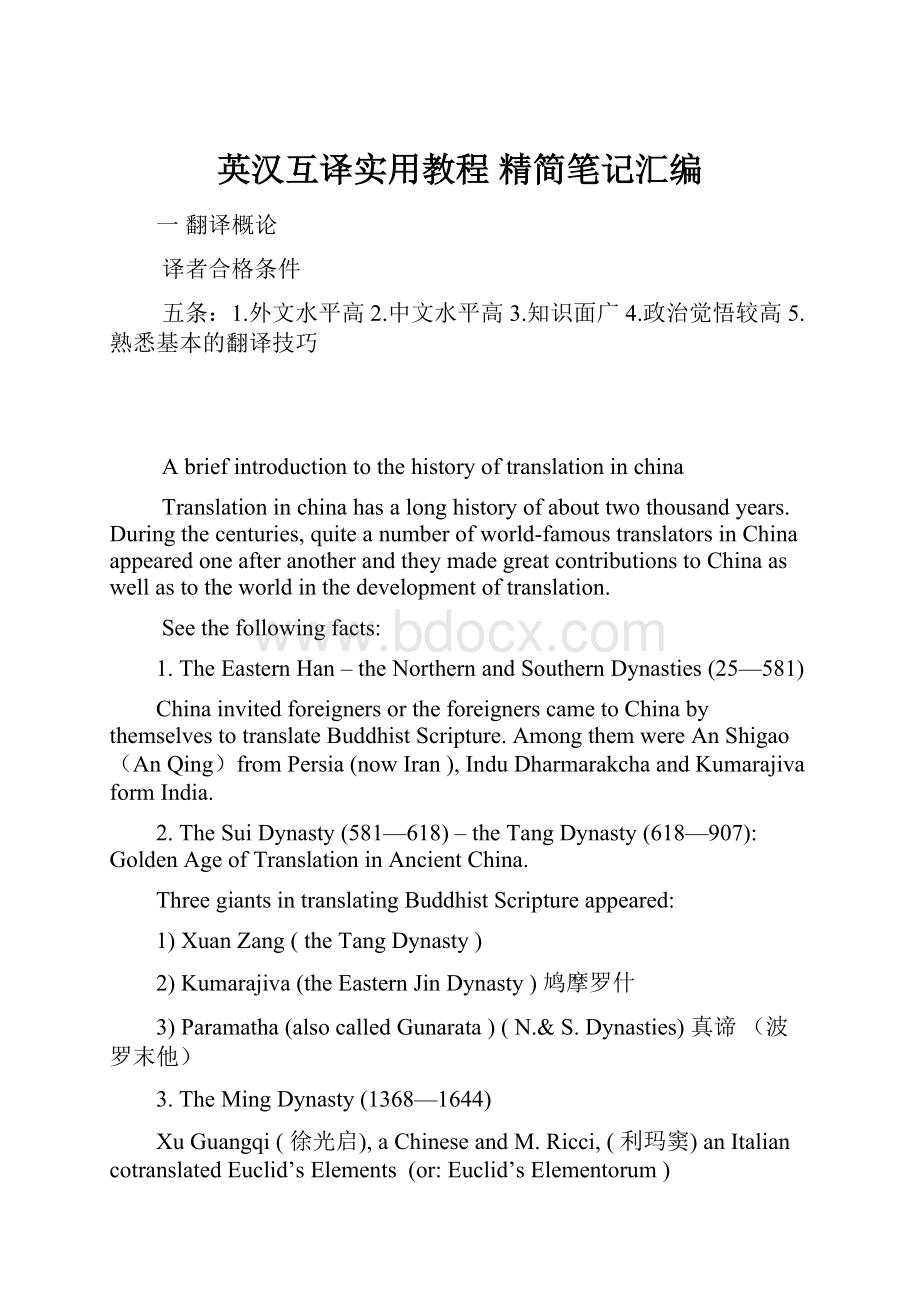英汉互译实用教程 精简笔记汇编.docx
《英汉互译实用教程 精简笔记汇编.docx》由会员分享,可在线阅读,更多相关《英汉互译实用教程 精简笔记汇编.docx(83页珍藏版)》请在冰豆网上搜索。

英汉互译实用教程精简笔记汇编
一翻译概论
译者合格条件
五条:
1.外文水平高2.中文水平高3.知识面广4.政治觉悟较高5.熟悉基本的翻译技巧
Abriefintroductiontothehistoryoftranslationinchina
Translationinchinahasalonghistoryofabouttwothousandyears.Duringthecenturies,quiteanumberofworld-famoustranslatorsinChinaappearedoneafteranotherandtheymadegreatcontributionstoChinaaswellastotheworldinthedevelopmentoftranslation.
Seethefollowingfacts:
1.TheEasternHan–theNorthernandSouthernDynasties(25—581)
ChinainvitedforeignersortheforeignerscametoChinabythemselvestotranslateBuddhistScripture.AmongthemwereAnShigao(AnQing)fromPersia(nowIran),InduDharmarakchaandKumarajivaformIndia.
2.TheSuiDynasty(581—618)–theTangDynasty(618—907):
GoldenAgeofTranslationinAncientChina.
ThreegiantsintranslatingBuddhistScriptureappeared:
1)XuanZang(theTangDynasty)
2)Kumarajiva(theEasternJinDynasty)鸠摩罗什
3)Paramatha(alsocalledGunarata)(N.&S.Dynasties)真谛(波罗末他)
3.TheMingDynasty(1368—1644)
XuGuangqi(徐光启),aChineseandM.Ricci,(利玛窦)anItaliancotranslatedEuclid’sElements(or:
Euclid’sElementorum)
4.TheQingDynasty(1644—1911)
ThereweregreattranslatorslikeYanFuandLinShu
LinShu:
1Camille(or:
LaDameauxCamelias)(《巴黎茶花女遗事》)
2UncleTom’sCabin(《黑奴吁天录》)
3DavidCopperfield(《块肉余生述》)
YanFu:
1EvolutionandEthicsandOtherEssaysbyT.H.Huxley(《天演论》)
2AnInquiryIntotheNatureandCauseoftheWealthofNationsbyA.Smith(《原富》)
3OnLibertybyJ.S.Mill(《群己权界论》)
4AHistoryofPoliticsbyE.Jenks(《社会通诠》)
习题
1.YanFu’s3-wordtranslationcriteriaarefaithfulness,expressivenessandelegance.(严氏三字真言)
2.ThetwowordsusedasthecommoncriteriaoftranslationinChinatodayarefaithfulnessandsmoothness.
3.Translationisarepresentationorrecreationinonelanguageofwhatiswrittenorsaidinanotherlanguage,notonlyanartbutalsoascience.(whatismeantbytranslation?
)
4.KarlMarxwasfondofsaying:
“Aforeignlanguageisaweaponinthestruggleoflife.”
5.Generallyspeaking,aqualifiedtranslatorshouldhavefiveprerequisites:
1agoodcommandofthesourcelanguage,
2agoodcommandofthetargetlanguage,
3awiderangeandscopeofknowledge,
4ahighpoliticalconsciousness,
5anecessaryknowledgeofbasictechniquesusedintranslation.
6.Tome,thecriteriaoftranslationshouldbethefollowingtwowords:
faithfulnessandsmoothness,orevenonlyoneword:
faithfulness.(whatdoyouthinkshouldbethecriteriaoftranslation?
)(faithfulness更重要)
“宁顺而不信。
”“宁信而不顺”
“itisbettertohaveasmoothversionthanafaithfulone.”“ratherbefaithful(inthought)thansmooth(inlanguage)
“保持着原作丰姿”
“keepthefullflavoroftheoriginalwork.”
直译与意译
Literaltranslationandliberal(free)translation
二大写,标点符号与英汉互译
大写规则
1.历史上的时间,时期和文件。
2.商品的牌子名称
3.星期名、月份、假日
4.人名和地名
5.标题与书名等专名中的实词与两个音节及其以上的虚词。
如《儒林外史》TheScholars
6.圣经中关于上帝的名词与代词
7.职称、头衔和亲属关系称呼用在人名前头时
8.机关、学校、建筑物和商业机构的名称,其中英译中的实词。
如:
教育部MinistryofEducation
9.种族、国籍、语言和宗教方面的词语。
10.其他一切有特殊含义的词语,包括一句话或一封信的开头词、诗行的开头词、直接引语的开头词、强调词语等。
几种标点符号的例句及其英译:
1.认识落后,才能去改变落后;学习先进,才有可能赶超先进。
Backwardnessmustbeperceivedbeforeitcanbechanged.Apersonmustlearnfromtheadvancedbeforehecancatchupandsurpassthem.(分号变句号)
2.许贞一把抱住秀云,惊异地问道:
“你这是怎么啦?
”
XuZhenhuggedXiuyunandinquiredinastonishment.“What’sthematterwithyou?
”(冒号变句号)
3.1)······和那墙头上“休谈国事”的招贴,形成一种奇怪的对比和讽刺。
...inironicalcontrasttothesignonthewall:
“Politicaldiscussionprohibited.”(逗号变冒号)
2)王冕看了一回,心里想道“古人说,‘人在画图中’,其实不错。
”
AsWangMianwatched,hethought,“Theancientssaid,‘Inabeautifulsceneamanfeelsheispartofapicture.’Howtrue!
”(加逗号,句号变感叹号)
4.“出去!
你们全都出去!
”秀云发出了命令。
“Clearout,allofyou!
”Xiuyunordered.(感叹号变逗号)
5.“你想要什么?
”他怒吼道。
“WhatdoYOUwant?
”hegrowled.(着重号变大写)
6.爱新觉罗·溥仪Aisin-GiorePuYi约瑟夫·布罗兹·铁托JosipBrozTito
7.1)据《大唐西域记》记载,那时龟兹有佛寺一百所,僧尼五千余人。
AccordingtohisTravelsintheWesternRegion,Qiuciboastedofmorethan100Buddhisttemplesand5000nunsandmonks.
2)《故乡》是《鲁迅短篇小说选》一书中最优秀的篇目之一。
“MyOldHome”isoneofthebeststoriesinthebookSelectedStoriesofLuXun.(文章、诗、短篇书名号变引号,书名的书名号变斜体)
8.司马相如者,汉蜀郡成都人也,字长卿。
SimaXiangru,anativeofChengduinShucountry,isalternativelynamedChangqing.(下划线去掉)
9.不管我在那里,我还是拿北京作我的小说背景,因为闭上眼睛想起的北京,是要比睁着眼看见的地方,更亲切、更真实、更有感情的,这是真话。
NomatterwhereIwas,IshouldliketowritemynovelwithBeijingasitsbackground.Forinmymind’seye,Beijingappearstomemoreintimate,moretangibleandmoreaffectionatethananyotherplaceIactuallysee.Thatisaplainfact.(顿号变逗号)
10.1)于是我自己解释说:
故乡本也是如此,——虽然没有进步,也未必有如我所感的悲凉。
ThenIrationalizedthemattertomyself,saying,Homewasalwayslikethis,andalthoughithasnotimproved,stillitisnotsodepressingasIimagined.
2)消息传到聂荣臻将军那里时,他让人把这两个日本小女孩接到前线司令部接待所——滹沱河畔一座小山庄里的一幢农庄。
WhenGeneralNieRongzhenlearnedaboutthegirlshehadthembroughttoacottageinamountainhamletbythesideoftheHutuoRiver,theguesthouseofthefrontlinecommandheadquarters.(破折号有时可译成句号或逗号)
英、汉标点对照
1.period(.)句号(。
)
ma(,)逗号(,)
3.colon(:
)冒号(:
)
4.semicolon(;)分号(;)
5.dash(-)破折号(——)
6.questionmark(?
)问号(?
)
7.quotationmark(“”or‘’)引号(“”或‘’)
8.exclamation(!
)感叹号(!
)
9.ellipsis(...)省略号(······)
10.parentheses(())括号(园)(())
11.brackets([])括号(方)(【】)
12.underliningRainbow书名号(手稿)(Rainbow或《虹》)
13.italicsRainbow书名号(印刷)(Rainbow或《虹》)
14.hyphen(-)(co-operate)(无对应的标点符号)
15.virgule(/)(he/she)(斜线号,一般汉译为“或”)
16.apostrophe(’)(Mike’s)(一般译为“···的”)
标点特别情况
(,)(you,heandI)顿号(你、我和他)
Apostrophe的译法1省字母号(I’m=Iam)2省音号(electric’lectric)3副数符号(manyM.P.’s)4所有格符号(boy’sbook)
习题
1.琼斯一家的汽车theJoneses’car
2.我几位嫂子的信mysisters-in-law’sletters
3.我表兄弟们的房子mycousins’houses
4.基辛格和尼克松的计划KissingerandNixon’sletters
5.尼克松和罗杰斯各自的计划Nixon’sandRogers’splans
三专有名词和其他一些名词的翻译
专有名词,指人名、地名、机构团体名和其他具有特殊含义的名词或名词词组
1外译汉
长期以来,由于我国在专有名词的翻译中缺乏统一的规定,所以存在着专有名词翻译的混乱情况。
如:
SirIsaacNewton奈端(现译:
牛顿)
Chicago诗家谷/支加哥(现译:
芝加哥)
连现在的一些普通名词,早先也有各种各样听来古怪的译名
Logic逻辑学:
严复译为“名学”;孙中山译成“理则学”
Philosophy哲学:
马相伯译为:
“致知”,蔡元培译为“道”
新中国成立以来,我国采取的措施来消除这些问题。
1)Followthepronunciationoftheownerofpropernames(名从主人)
2)UsethestandardpronunciationoftheChinesecharacter(标准汉音)
3)Adopttheestablishedpopulartranslatednames(约定俗成)
约定俗成的几个例子:
Caesar凯撒Eden艾登Bethune白求恩Athens雅典Seattle西雅图
关于外国专有名词汉译的问题,还要记得两点:
一是外国人的名字,特别是长期住在中国、工作在中国的一些外国人,往往喜欢把自己的名字中国化,即听起来很像中国人的姓名;二是音译要采用译音表所规定的汉字,不要用那些容易引起联想的字。
外国专有名词的意译:
一般来说,大多数专有名词用音译;但有一部分确有明确含义者,应用意译.
各学科的术语和某些普通名词的翻译规则
TheTranslationofTechnicalTermsandOtherCommonNouns
Nothinggivesthetranslatormoretroubleandmoreperplexitythanthetranslationoftechnicaltermsofsocial,naturalandmilitarysciences.Technicalterms,especiallythoseofnaturalsciences,weregenerallyintroducedtousfirstthroughtransliterationandlater,somehavebeensubstitutedbytheirsemantictranslations,suchastelephone,penicillin,etc.OtherswhichcanhardlybetranslatedsemanticallyinafewChinesecharactersretaintheirtransliterations.Theyare:
Soviet,radar,morphone,engine,etc.Thesetermscontainmuchinthemandarelikelytobemisrepresentedofdistortedinmeaning,ifotherwisetranslated.People,therefore,prefertokeeptheirtransliterations,iftheyareshortandeasytoberemembered.AlmostallthetermsinBuddhismweretransliteratedandafterwardshortened,suchasthetranslationsofthewordsthupo(塔),sangha(僧),etc.
Mostofthetechnicalterms,especiallythoseofmilitaryandsocialsciences,aretranslatedsemantically.Typicalexamplesofmilitarytermsarejetplane,submarine,machinegun,guidedmissile,etc.TermsofasocialnatureareBuddhism,Marxism,etc.
Besidesthetransliterationandthesemantictranslation,thereisathirdwayoftranslatingtechnicaltermsandothercommonnouns,i.e.,tocoinnewChinesecharactersifneedbe.Inthetranslationofchemicalelementssuchasoxygen,hydrogen,antimony,tungstenandsomeothernamesascoffee,pump,typhoon,etc.,thenewcoinedChinesecharactersareused.
1.Puretransliteration
Chocolate巧克力sofa沙发morphine吗啡khan可汗
2.Puresemantictranslation
Airplane飞机president总统truth真理bread面包
3.Bothtransliterationandsemantictranslation
Club俱乐部Utopia乌托邦typhoon台风romantic浪漫
4.Transliterationwithsemantictranslationattheend
Beer啤酒cigar雪茄烟czar沙皇card卡片jeep吉普车
5.Symbolicaltranslationwithasemanticexplanationattheend
Cross十字架pyramid金字塔grape葡萄弹mattock鹤嘴锄
2.汉译外
TheTranslationofChineseNamesofPersonsandPlacesIntoEnglish
TheWade-GilesSystem(威妥玛-贾尔斯系统)hasbeenappliedtothetransliterationofChinesewordsintoEnglishforalongtime.ThesystemwasinitiatedbyThomasFrancisWade(威妥玛),whopublishedhissystemfirstin1859.Asbothanimperialistagentanda19thcenturysinologist(汉学家),hehadlivedinChinaforscoresofyearsbeforehebecametheBritishMinisterPlenipotentiarytoChina(英国驻华全权公使)intheQingDynasty.
Therearecaseswhereseveralnamesrepresentthesameperson.Sometimes,atitleornicknameisalsousedtofulfillthefunctionofarealname.WecanfindalotofexamplesinourChinesenovels.Thetroubleisthatallthedifferentnamesofthesamepersonmaycomeoutalternativelyinthesamestoryoreveninthesameparagraph.Inorderthatnotraceofambiguityostobeleftintheversion,atranslatorhasgottowardoffanypossiblemisplacement.Inthisconnexion,hemaytransliterateonlyoneofthedifferentnamesanduseitforalltherestortransliterateallofthemandgiveanexplanationtoeachbywa